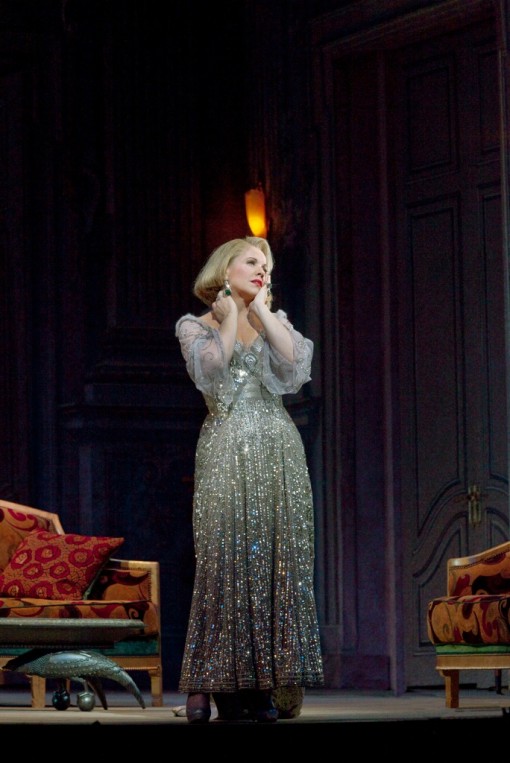With Fleming at the center, Met’s “Capriccio” proves special indeed

Renée Fleming stars as the Countess in Richard Strauss's "Capriccio" at the Metropolitan Opera. Photo: Ken Howard.
The Metropolitan Opera waited until the 1998-99 season to present Strauss’s Capriccio, and until last night John Cox’s production had not been seen since. It was high time for a revival, particularly in light of the success Renée Fleming has had elsewhere in the role of the Countess during the intervening years. Met audiences had a chance to sample Fleming’s interpretation of the Final Scene at a gala built around her, which opened the 2008-09 season. Her assumption of the role in its entirety proves well worth the wait, even if it might have been even better earlier.
Like Tosca, Capriccio is one of those operas firmly planted in its own time and place: a chateau near Paris in the 1770s. In Cox’s production, revived by Peter McClintock, the place remains the same but the time is moved up to the 1920s, with surprisingly satisfactory results. For one thing, one could imagine the grand salon meticulously depicted in Mauro Pagano décor, with its mixture of antiques and contemporary French furniture and its elaborate murals, looking pretty much the same 150 years before. Therefore, it is really the costumes (which have been redone by Robert Perdziola for this revival) that make the difference. And when the Count (the Countess’s brother) appears costumed for a play in traditional 18th century garb, complete with powdered wig, you feel a sense of relief that, in this “conversation piece for music,” the men converse in natty fashions from the 1920s.
On the other hand, the whole premise of Capriccio—a debate about whether words or music should take priority in opera—is so 18th century. This was a period rich in controversies about the nature of opera. The idea behind Capriccio was in fact inspired by an 18th-century libretto, Prima la musica e poi le parole by Giovanni Battista Casti, which was set by Antonio Salieri. And I doubt if there were many French chateaus in the 1920s where, as here, guests mentioned the names of Lully, Rameau, Couperin, Gluck and Piccinni. And if they did, they would surely have talked about Meyerbeer, Berlioz, Bizet and Massenet too. In any case, Capriccio is treated with the requisite elegance, and that is the important thing.
The choice between music and words is personified by the composer Flamand and the poet Olivier, each of whom is enamored of the Countess. It is left to the Countess, a young widow, to resolve the theoretical issue, a decision that by implication will also determine which of the two men will be her next husband.
This puts the Countess at the center of the opera, a circumstance that Fleming finds most congenial. The voice has become increasingly delicate and does not always sound pure in tone. But it still has the ability to captivate, as she proved above all in the Final Scene, in which the Countess wrestles with her dilemma. There was some lovely pianissimo singing, but equally if not more important a compelling way with coloring words and shaping phrases. Fleming’s singing is often called mannered, but without keen attention to every detail this music will fall flat. Fleming is very moving when the Countess wonders if she can supply an ending that is not trivial.
Her decision is supposedly made as she looks at herself in the mirror, but there is no mirror here. Perhaps as a substitute, at the start of the Final Scene she is served a dry martini, a symbol of the 1920s but timely in any age. Before going in for dinner, she devours the olive with a carefree glee that dispels undue sentimentality, then scribbles a note that presumably sets forth her decision.
The rest of the cast is excellent. Tenor Joseph Kaiser, sometimes a little fluttery of tone, brings to Flamand an ardor that bespeaks his musical calling, and baritone Russell Braun sings handsomely as Flamand’s more urbane rival Olivier. Bass Peter Rose, as the theater director La Roche, a character apparently modeled on the great Max Reinhardt, has his own idea of what takes priority: putting on a good production, a subject he expounds on eloquently in a scene in which Rose’s robust bass is heard to fine effect.
The Count has his own view about opera—he doesn’t like it at all—and baritone Morten Frank Larsen, in his Met debut, offers an appealing portrayal of this more down-to-earth character. Mezzo Sarah Connolly sings sumptuously and ensures that the famous actress Clairon has ample character.
Strauss included a number of diversions to supply contrast with the opera’s more theoretical moments, including a dance sequence (choreography by Val Caniparoli) zestily performed by Jennifer Goodman—who, borne aloft, comes at Clairon with legs like weapons—and Griff Braun. Later, a parody of an Italian opera duet is delightfully sung by Olga Mararina and Barry Banks.
Sir Andrew Davis, who conducted when the production was new, shows a fine feeling for the delicate textures and other musical delights of Strauss’s score, which contains allusions to his own music and that of others. From the unusual prelude, a sextet for solo strings, Davis makes it clear that Capriccio is indeed a special opera.
Capriccio runs through April 23. http://www.metoperafamily.org/metopera/season/production.aspx?id=10916